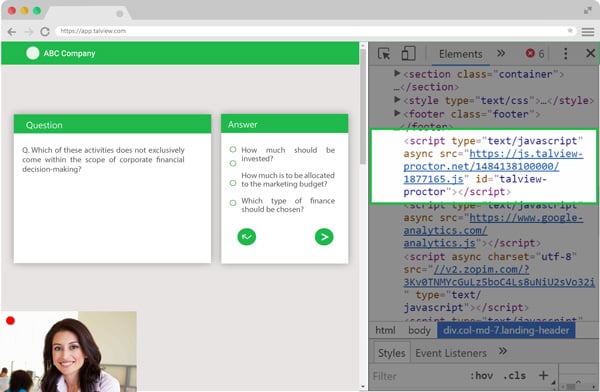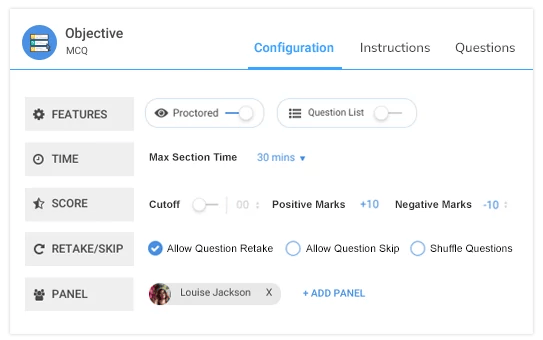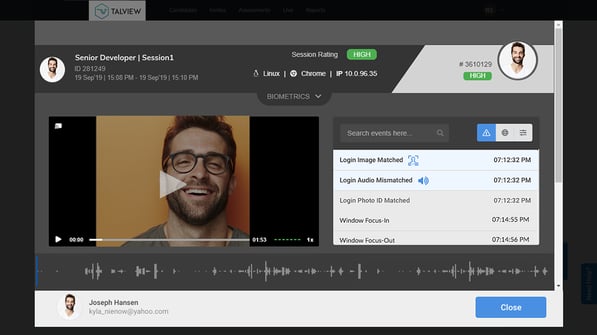Online remote proctoring is trending now more than ever. The advent of remote proctoring has helped many universities and learning centres to move pen-and-paper exams to a completely online process.
This shift in the education sector not only eases the administrative burden of hosting exams every other month but it also enables students to take exams from the comfort of their homes.
Our guide to online exam proctoring covers the following topics:
What does online remote proctoring mean?
Online remote proctoring is a modern method of assessment that allows one to conduct exams online, which can be monitored remotely from any location to avoid cheating. This technology enables students to take online assessments without any physical proctoring to ensure the authenticity of the exam.
A proctor is simply an invigilator whose job is to overlook test takers during examinations for the main purpose of ensuring that they don’t cheat.
An advanced remote proctoring software is easily integrated with any Learning Management System (LMS) or website that needs to be proctored and imitates the function of an on-site proctor.
While some see virtual proctoring as a great way of expanding online courses and upgrading the education system with the much-needed technological shift towards eLearning, others see it as an excellent opportunity to put an end to cheating by students in exams.
The boom in eLearning in the past decade has led to the increased popularity of many LMSs, social learning programs, course retailers, online course marketplaces, mobile learning platforms, and more.

According to the same marketing studies, the global eLearning market is expected to reach $325 billion by 2025 (Research and Markets) from $107 Billion in 2015.
Owing to the strict quarantine measures presently, schools, colleges, and universities remain closed and students worldwide remain at home. However, teaching cannot stop. This is why educational institutes are rapidly turning to eLearning to safely administer lectures and exams.
Almost all top-ranked education universities have postponed the SATs for the coming academic year and the College Board even announced that they might be held digitally if the situation doesn’t fall under control by August 2020. Even the GRE, GMAT, and a few other exams are being held online, according to the Daily Tar Heel.
This shift from classroom to online teaching has been made possible through eLearning platforms. Online learning platforms replicate face-to-face classroom environments by allowing teachers to virtually assign tasks, share course material, collect homework, and conduct exams.
What is an online proctored exam?
Online proctored exams can be defined as assessments taken online by students using a mechanism that ensures the test taker's authenticity and prevents him/her from cheating.
This is made possible through either a real-time test proctor present online during the duration of the assessment via webcam surveillance or with the help of AI-led online proctoring software that takes pictures of the test taker at random times during the test to assess later.
Online proctored exams are organized via a computer or mobile phone, and requires a stable internet connection, a mic, and a webcam.
Online proctored exams offer numerous benefits. One main benefit is that the candidate is monitored throughout the exam without an actual physical proctor present with the test taker, eliminating the need for a proctor every time you need to hold an exam.
Apart from that, web-proctored tests remove the logistical burden of holding physical examinations in schools, universities, and learning centres.
The conventional way of conducting assessments comprises booking an exam hall/test centre, informing candidates, supervising the exam, evaluating the test copies, and finally declaring results. With e-learning, most of these processes are deemed redundant.
To get an in-depth understanding of remote proctoring and its different variations available in the market today, you can read our blog post on Online Proctoring.
You’ll need to understand how online exam proctoring works to select the software or service that will host your lessons, lectures, and exams.
How does online exam proctoring work?
Online proctored exams are timed exams that are taken online while the proctoring software monitors the test takers’ computer browser activity, webcam video, and audio during the exam.
The data recorded by the proctoring software can be transferred to a proctoring service (a group of qualified professional proctors) for review.
The latest online remote proctoring solutions, however, use Artificial Intelligence to proctor these tests and, hence, require no proctor or third party proctor services.
The software automatically red flags test-takers who show suspicious activity during the test, such as switching browser tabs or copying/pasting answers.
But before the test begins, the candidate is required to fill in their details like name, date of birth, age, and gender to ensure their authenticity. Then on the authorization page, the test taker is expected to submit an ID proof for facial recognition. In the same step, the microphone and webcam are tested to avoid any errors during the assessment.
Once that is done, then the real assessment can begin. These assessments will vary in type depending on whether they are live proctored, or pre-recorded.
For auto-proctored exams, the test taker receives a set of questions (in text format) one by one on their screen. These questions are timed, and hence, they require the test taker to record their answer in a video at the designated time.
Whereas for live proctoring exams, there is a qualified proctor who looks over the test taker’s live feed and red flags for any suspicious activities in real-time.
Traditionally, remote live proctoring has been used as the safest method of conducting exams remotely, but over time it has proved to be neither scalable nor feasible due to data security concerns. Hence, automated proctoring has become a much popular choice.
Use case #1 - How can schools and universities benefit from proctored exams?
 Easy configuration of online assessments
Easy configuration of online assessments More than 500 universities in the US including Arizona State University, California State University use online proctored exams. Here’s why:
-
Relevant: Generation Z is adept in all kinds of technologies and is accustomed to the fast-paced world. For them, traditional classroom training may seem obsolete and sometimes boring. Thus, adopting eLearning methodologies to teach them would prove to be more successful and would make learning seem more relevant and easy for children.
-
Accessible: The fact that these classes and exams can be taken from any part of the world, makes them highly accessible and hence, doesn’t limit the capacity of students undertaking them. Students and teachers don’t have to travel to a designated test center to take these tests at a particular time.
-
Cheat-proof: Since schools and universities are examination hubs, there’s also a lot of scope for cheating during exams. An online proctored test ensures that students cannot cheat, as each test taker has to ensure that they’re sitting alone in a room while taking an online exam, along with other rules that are put in place to make online exams cheat-proof digitally.
Also, it is very hard to cheat when an unseen invigilator is viewing you constantly via a large video screen, in case of live proctored exams.
-
Student Authentication: Along with cheat-proofing, the authenticity check at the beginning of the test nullifies any chance of impersonation or any other malpractice during the test. Some proctoring services even provide a two-factor authentication to be very sure of who is taking the test. This is one of the major concerns for parents or teachers when it comes to online exams.
-
Convenient: When setting up an online exam or assessment, you don’t need to create a spreadsheet with students’ names and IDs – it’s all available on the proctoring software. Everything can be done with the click of a button.
-
Quick Results: n an online exam, the results are calculated instantly and accurately by the software. In a paper-based examination, the paper evaluation process takes up a lot of time and is also prone to human errors.
Use case #2 - How can learning centres/certification providers benefit from proctored exams?
Massive Open Online Courses like UNE and Coursera also make use of proctored exams for online courses successfully.
-
Self-paced: Online courses are self-paced and one should be able to complete them at their own pace and convenience. Since the students and instructors don’t interact in real-time, the students can pause and resume the courses whenever they feel like.
This ensures that people who are taking up these courses while having a full-time job or other priorities are still able to pursue a course of their choice without having to stress about deadlines.
-
Exams on-demand: If no live proctors are required for testing, students can take the exam at any hour without the need to have a proctor available at all times.
-
Scalable: Due to geographical limitations, traditional classroom education is very limited in its accessibility. However, through eLearning, the reach can be much wider. Remote classes are highly scalable and can accommodate as many students as you want from possibly any part of the world.
-
Growing Demand: By enabling students to take up the course at their own pace, they have become a very popular choice for people wanting to hone their skills or specialize in a certain field. This ensures that the learning centres are always in demand and running.
-
Cost-effective: Since there are no logistical costs, such as hiring a proctor, an examination center, question papers and answer sheets, etc., online courses become a more economical alternative that is widely chosen by many.
-
Easy Audits: With the tests being proctored, you will always have recorded proof to present during audits. You won’t have to create paperwork from scratch last minute or worry about surprise audits.
Can you cheat on online proctored exams?

Online proctoring tools use algorithms and machine learning to deter cheating by automatically identifying cheating-like behavior during online assessments. The technology tracks and learns student behaviors and patterns during the assessment which helps to track malpractice and cheating during the exam.
To ensure the test is not taken by anyone apart from the person enrolled in the course, online proctoring solutions often use secure browsers.
Certain controls, such as student authentication, face/voice match and face/voice activity detection, and restriction of test access, are enabled so that the test will only begin once the actual student sits in front of his system.
The teachers can decide how much flexibility students have to access certain web pages or applications. Some proctoring services send a trigger when, during the exam, the test taker is found to switch browser windows or tabs or is copy/pasting from some other browser or document.
It also notices the test takers' exam-taking environment to check for any kind of malpractice and if the test taker is in their designated place for the duration of the test.
More so, if you decide to use a live proctoring software, that will reduce a lot of these additional steps since a live proctor will be sharing the screen of the test taker.
With these steps in place, online proctored exams are completely secure and probably more cheat-proof than face-to-face exams.
Are there any privacy concerns?
A smart and reliable proctoring service will provide you with full transparency regarding all the data being used, where it is being used, why it is being stored and how it is being discarded after a test is over.
To ensure that you’re not using a fraud remote proctoring system, the solution should be noninvasive and have privacy protection. It should be legally certified to hold proctored exams on its platform. Hence, you need to do a proper and thorough background check on your proctoring software.
Proctors should not have to access a user’s device and data files to verify test compliance. As mentioned in the blog post earlier, there are many other ways to check and give cheat-proof clearance to the test taker.
The security measures need to be integrated and automated to ensure proper compliance and client privacy, reduce security risks, and, in the process, provide a smooth user experience.
Conclusion
This world has morphed into a large online learning experiment, with us testing the limits of education technology. Online proctoring, being one of them, has become an essential part of eLearning and is proving to be a trend that is here to stay. Along with that, as AI in proctoring services becomes smarter, it will continue to make exams more easier, handy, and authentic.
Want to see how Talview helps universities and learning centres with remotely proctored exams? Request a demo tour.








Leave a Reply